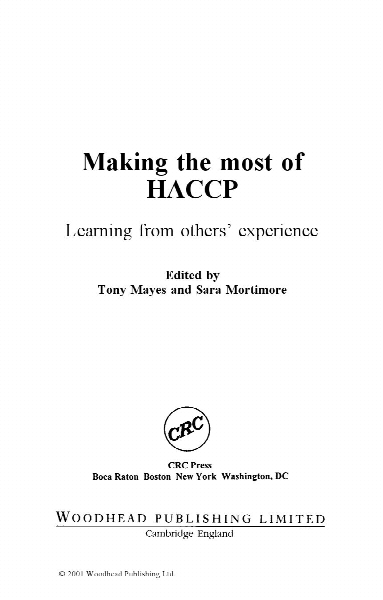Making the most of HACCP : learning from others' experience
- نوع فایل : کتاب
- زبان : انگلیسی
- مؤلف : Tony Mayes; Sara Mortimore
- ناشر : Boca Raton, Fla. : CRC Press ; Cambridge, England : Woodhead Pub
- چاپ و سال / کشور: 2001
- شابک / ISBN : 9781591243403
Description
Preface and acknowledgements List of contributors List of acronyms and abbreviations 1 Introduction T. Mayes, Unilever Research, Sharnbrook and S. Mortimore, Pilsbury Europe, Uxbridge 1.1 The development of HACCP 1.2 HACCP in practice 1.3 Key themes 1.4 References Part I Small and medium-sized enterprises (SMEs), retailers and HACCP systems 2 HACCP and SMEs: problems and opportunities E. Taylor, The University of Salford 2.1 HACCP and SMEs 2.2 Setting up the HACCP system 2.3 Operating the HACCP system 2.4 Conclusions 2.5 References 3 HACCP and SMEs: a case study N. Route, formerly Food and Spice Group, Tunbridge Wells 3.1 Why bother with HACCP? 3.2 The company Contents © 2001 Woodhead Publishing Ltd. 3.3 Scope and resources 3.4 HACCP planning and implementation 3.5 HACCP and supplier operations 3.6 Keeping up to date with HACCP 3.7 Summary 4 Supplier HACCP systems: a retailer’s perspective M. Kane, Food Control Limited, Cambridge (formerly Head of Product Safety, Sainsbury’s Supermarkets Limited) 4.1 Introduction 4.2 Retailers and the development of supplier HACCP systems 4.3 Assessing the effectiveness of supplier HACCP systems 4.4 Gauging the success of HACCP systems: customer complaint data analysis 4.5 Common weaknesses in HACCP systems 4.6 The future development of HACCP 4.7 Conclusions Part II Larger manufacturers and HACCP systems 5 HACCP implementation in the United States T. R. McAloon, Cargill Inc., Minneapolis 5.1 Introduction 5.2 Setting up the HACCP system 5.3 Implementation challenges and solutions 5.4 Surprises in HACCP implementation 5.5 Operating the HACCP system 5.6 HACCP management challenges and solutions 5.7 The benefits of a HACCP system 5.8 The future evolution of HACCP systems 5.9 Conclusion 6 HACCP implementation: the Indian experience B. Marthi, Hindustan Lever Limited, Mumbai 6.1 Introduction 6.2 The food industry in India 6.3 Food safety in India 6.4 The development of HACCP systems in India 6.5 HACCP implementation: the Unilever approach in India 6.6 HACCP implementation in practice: the marine products model 6.7 Maintaining HACCP systems 6.8 The benefits of HACCP implentation 6.9 Difficulties in HACCP implementation 6.10 The future of HACCP implementation in India 6.11 Bibliography © 2001 Woodhead Publishing Ltd. 7 Implementing HACCP systems in Europe: Kerry Ingredients D. Rudge, Kerry Ingredients, Bristol 7.1 Introduction 7.2 HACCP and business strategy 7.3 How big is the job? 7.4 Prioritisation in the project plan 7.5 The Polish experience 7.6 Expansion of the Polish operation 7.7 Kerry Ingredients, Portbury, UK 7.8 The benefit of hindsight 7.9 References 8 Implementing HACCP systems in Europe: Heinz D. Killen, H. J. Heinz, Wigan 8.1 Introduction 8.2 The manufacturing background 8.3 The main hazards 8.4 Introducing the HACCP programme at Kitt Green 8.5 Scope, approach and timing 8.6 Setting up the managing HACCP teams 8.7 Prerequisites 8.8 Hazards and CCPs 8.9 Implementation and verification 8.10 Keeping up to date 8.11 Benefits and drawbacks of HACCP implementation 8.12 References Part III Regulation and training 9 HACCP enforcement in New Zealand J. A. Lee, Food Assurance Authority, Ministry of Agriculture and Forestry, Wellington 9.1 Introduction 9.2 Developing HACCP assessment 9.3 Assessment of the HACCP system 9.4 Conclusion 9.5 References 10 Enforcing safety and quality: Canada V. McEachern, A. Bungay, S. Bray Ippolito and S. Lee-Spiegelberg, Canadian Food Inspection Agency, Nepean 10.1 Introduction 10.2 The background to food safety inspection in Canada 10.3 Enforcement: from product to systems inspection © 2001 Woodhead Publishing Ltd. 10.4 HACCP as an industry control system 10.5 Government food safety programs 10.6 Regulatory verification versus audit 10.7 Regulatory verification of company food safety systems 10.8 Common barriers to regulatory verification 10.9 Future trends: the Integrated Inspection System 10.10 Summary 11 HACCP implementation in the Thai fisheries industry S. Suwanrangsi, Department of Fisheries, Bangkok 11.1 Introduction 11.2 The international fish trade 11.3 The fisheries industry in Thailand 11.4 The Fish Inspection and Quality Control Division 11.5 The need for HACCP in the fisheries industry 11.6 Hazards associated with fishery products 11.7 Key issues in HACCP implementation 11.8 Preparing for HACCP implementation 11.9 Designing the HACCP system 11.10 Implementation issues 11.11 Measuring success: the benefits of HACCP implementation 11.12 Conclusions: the future of HACCP 11.13 References 12 Implementation and enforcement in the United Kingdom J. Barnes, Food Standards Agency, London 12.1 Background 12.2 UK legal requirements for HACCP 12.3 The regulatory authorities 12.4 Take-up of HACCP by the UK food industry 12.5 HACCP and enforcement 12.6 Common problems with HACCP systems 12.7 Future HACCP arrangements 12.8 A personal perspective 12.9 References 13 Effective HACCP training C. Wallace, Reading Scientific Services Limited, Reading 13.1 Introduction 13.2 Training needs analysis 13.3 Training and effective learning styles 13.4 Appointing HACCP trainers 13.5 Training and senior management 13.6 Training the HACCP team and team leader 13.7 Training CCP monitors and others © 2001 Woodhead Publishing Ltd. 13.8 Special issues in training 13.9 Summary 13.10 References Part IV Conclusion 14 Conclusions S. Mortimore, Pillsbury Europe, Uxbridge and T. Mayes, Unilever Research, Sharnbrook 14.1 Introduction 14.2 Learning 1: drivers for HACCP 14.3 Learning: 2 people 14.4 Learning 3: preparation for HACCP 14.5 Learning 4: HACCP plan development and implementation 14.6 Learning 5: HACCP maintenance activities 14.7 Where next for businesses with HACCP systems? 14.8 Summary 14.9 References 15 The future of HACCP T. Mayes, Unilever Research, Sharnbrook and S. Mortimore, Pillsbury Europe, Uxbridge 15.1 Globalisation and harmonisation of trade 15.2 Changing role of governments and regulatory bodies 15.3 The role of HACCP in new science/food safety initiatives 15.4 Application of HACCP further along the supply chain 15.5 The continued development of HACCP 15.6 Summary 15.7 References


